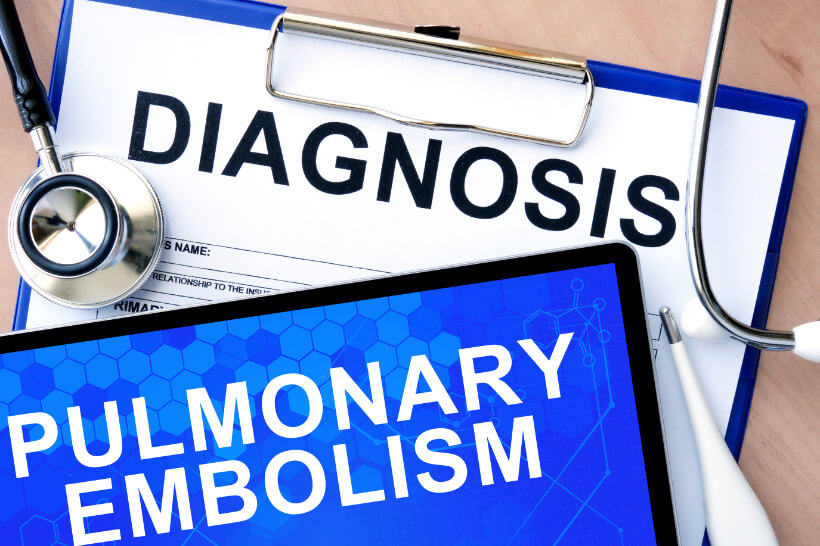
What’s a pulmonary embolism?

A pulmonary embolism is a blockage in an artery in the lung; the blockage is usually a clot. The blood clot usually breaks free from another part of the body and travels to the lungs. Once in the lungs, the clot can cause serious complications. A pulmonary embolism can even be a life-threatening condition, especially if it is a large clot or there are several clots present.Medical professionals do not know exactly how many people have pulmonary embolism, but the condition could affect as many as 900,000 people in the United States each year, according to the Centers for Disease Control and Prevention (CDC). The condition claims 60,000 to 100,000 American lives yearly.
Am I at risk for pulmonary embolism?
Anyone can develop a pulmonary embolism (PE), although certain factors can increase your risk for developing one. These risk factors include:
- Surgery, particularly joint replacement surgery
- Certain medical conditions, including cancer, lung disease, and cancer
- A broken leg, fractured hip, or other trauma
- Taking birth control pills, hormone replacement therapy (HRT), or other hormone-based medicines
- Pregnancy and childbirth, with the highest risk occurring about six weeks after childbirth
- Being motionless for a long time, such as being on strict bed rest, having a cast, or taking a long airplane flight
- Age – the risk for PE increases as you get older, especially after the age of 40
- Family history and genetics
- Obesity
What are the symptoms of pulmonary embolism and blood clots?
A pulmonary embolism does not always cause symptoms. In fact, half of all people who develop a PE experience no symptoms. Those who do have symptoms of pulmonary embolism experience shortness of breath, coughing up blood, or chest pain.
Symptoms of a blood clot include warmth, swelling, redness, pain and tenderness of the leg.
How do doctors diagnose pulmonary embolism?
PE can be difficult to diagnose. To make the diagnosis, your doctor or healthcare provider will review your medical history and perform a physical examination. Next, the clinician will order imaging tests, such as computed tomography (CT) scans. These tests help your doctor detect and evaluate your lungs.
What are the treatments for PE?
Pulmonary embolism requires immediate medical treatment, which focuses on breaking up clots and keeping other clots from forming. Treatment typically includes medications and procedures.
Medications
Medications include blood thinners, also known as anticoagulants, which prevents blood clots from getting larger and stops new clots from forming. Your doctor may order anticoagulants in pill form or through an intravenous (IV) needle.
Thrombolytics are a type of medicine that dissolves clots. Your doctor may order them if you have especially large clots that are causing severe symptoms or severe complications. Thrombolytics have the potential to cause sudden bleeding, so your doctor may order them only if your PE is serious and life-threatening.
Procedures
Your doctor may order a procedure to remove the blood clot. In one such procedure, known as catheter-assisted thrombus removal, a medical professional uses a flexible tube to reach a blood clot in your lung. Next, the clinician may insert a tool into the tube that allows them to break up the clot or to deliver medications through the tube. To undergo this procedure, your doctor will likely administer general anesthesia so that you sleep comfortably through the process.
Doctors sometimes recommend the placement of a filter inside a large vein, known as the vena cava. The filter catches any blood clots flowing through this vein before the clots reach the lungs, which prevents the development of pulmonary embolism. This vena cava filter is helpful in some people who cannot take blood thinners.
Can I prevent a pulmonary embolism from developing?
The best way to prevent PE is to stop new blood clots from forming in the first place. Prevention may include:
- Taking blood thinners
- Regular checkups with your doctor to ensure that the dosage of your medicine is working to prevent the formation of blood clots, but is not causing bleeding
- Lifestyle changes to improve heart health, including healthy eating and regular exercise
- Quitting smoking, if you smoke
- Using compression stockings, which are snug stockings that keep blood flowing to prevent the formation of clots in veins deep inside muscle tissue, known as deep vein thrombosis (DVT)
- Moving your legs around after sitting or being in bed for a long time, such as when you are on long car trips or airplane rides
- Moving around as soon as possible after undergoing surgery or being on bed rest
For more information on pulmonary embolism, consult with your doctor or healthcare professional. Determining your risk for developing PE can help you take action to avoid experiencing this serious health condition.




